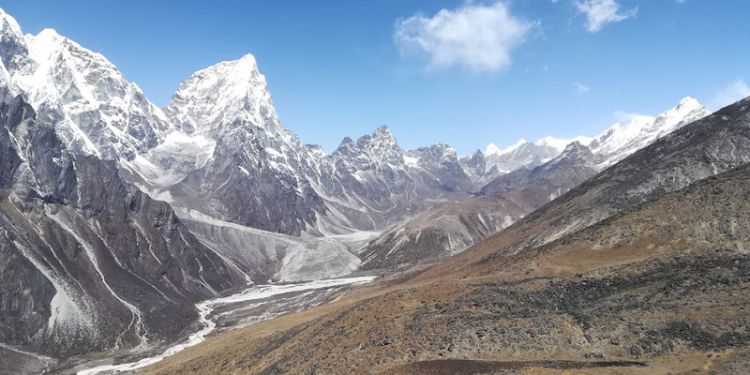
Anya Schlich-Davies
- Course: PhD in Glacier modelling
- PhD title: Himalayan glacier response to future atmospheric forcing
- Nationality: United Kingdom
Anya Schlich-Davies focuses on glacier modelling using climate data from the Khumbu region of Nepal for her funded PhD research. She calculates how glaciers and the South Asian monsoon, both vital sources of water among communities, may change in the future as a result of a changing climate. A member of the Institute for Climate and Atmospheric Science, as well as the Atmospheric and Cloud Dynamics and Climate Science and Impacts research groups, Anya is supervised by Drs Andrew Ross and Duncan Quincey. Her research was funded by the University of Leeds.
Anya said: “I hope to quantify the projected changes to the Khumbu region under future emissions scenarios, and different modelled monsoon scenarios. Glaciers in this part of the world act as vital water resources to downstream communities, as does the South Asian monsoon, and so calculating how both of these may change is really important.
Glaciers in this part of the world act as vital water resources to downstream communities, as does the South Asian monsoon, and so calculating how both of these may change is really important.
“My funding is from the University of Leeds and the Priestley International Centre for Climate. In the middle of my PhD I did a six month placement with the Government’s Department for Business, Energy and Industrial Strategy (BEIS) International Climate Science team. As I was on a good salary, I also managed to save money in advance of the funding coming to an end.”

Anya uses modelling techniques to calculate how glaciers and the South Asian monsoon, both vital sources of water among communities, may change in the future as a result of a changing climate.
Bringing meteorology and glaciology together
Anya’s research involves using two glacier models to quantify the sensitivity, uncertainty and projected changes of the Khumbu glacier under climate change. The Khumbu glacier flows down the southern flanks of Mount Everest, and has the highest accumulation area in the world, she explained.
“Climate model data used to drive glacier models are of very coarse spatial resolution. So before using any climate model data, I have performed statistics to downscale the large-scale model output to a more local, representative scale.
“These glaciers are different to most, as their melt and accumulation season overlap during the South Asian monsoon. Therefore getting the climate data as close to reality as possible is really important for the glacier modelling.”
She continued: “I have run hundreds of simulations using the two glacier models. One model is driven by local, hourly meteorology to simulate the balance of glacier melt and accumulation, or ‘mass balance.’ The results from this are then fed into an ice flow model, which is used to simulate the past, present and future evolution of the glacier under different emissions scenarios.”
The results are fed into an ice flow model, which is used to simulate the past, present and future evolution of the glacier under different emissions scenarios.
She added: “Models are never perfect, and accepting that and knowing how we deal with the uncertainty has been a real learning curve during my PhD. However, with the support of my supervisors it has been great.”
Anya’s PhD is a 50-50 split of meteorology and climate sciences, and glaciology. These interests are reflected in the academic interests of both of her supervisors.
My interests are reflected in the academic interests of both of her supervisors… and I have felt supported in both research areas.
“This has worked really well and I have felt supported in both research areas,” said Anya. “This support was particularly necessary for the meteorology side, as I started with little grounding in this area. One supervisor in particular knows so much about the glacier and surrounding area, which is really helpful.”
Deciding to pursue a PhD
Anya decided to pursue a PhD at the University of Leeds while carrying out a Masters in Polar and Alpine Change at the University of Sheffield. During this time, her interest in climate change developed, Anya explained. Initially, she realised her true passions for the subject during her undergraduate research project.
Anya said: “For my Masters thesis I used satellite imagery to look at how phytoplankton was changing in the Russian Arctic seas, and considered the feedbacks and implications this would have for ocean surface albedo and carbon drawdown.
“However conducting fieldwork for my undergraduate dissertation on Swiss glaciers and being lucky enough to go to Svalbard during my Masters really ignited my interest in glaciers. Our understanding of Himalayan glaciers has grown so much throughout my PhD, but there is still so much left to find out.”
Being part of such an impressive, large group of postgraduate researchers makes me feel like I am... part of a community. This has been particularly important since COVID-19.
She added: “Being part of such an impressive, large group of postgraduate researchers makes me feel like I am not alone in my research, but part of a community. This has been particularly important since COVID-19, and events such as the Shut up and Write sessions at The Library Pub have been so helpful.”
Further information
For more information about studying for a PhD in the School of Earth and Environment, visit our research degrees pages.
Search for funding, research areas, opportunities, supervisors and projects at phd.leeds.ac.uk.

